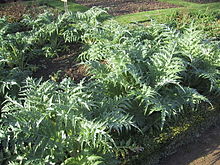Cardy


Cardy ( Cynara cardunculus ), other common names are Spanish artichoke , vegetable artichoke and cardoon , denotes a thistle-like , strong cultivated plant from the daisy family (Asteraceae). This group of varieties is grown for their fleshy leaf stalks that are used as vegetables. The artichoke is also part of Cynara cardunculus .
description
The artichoke is similar in all respects to its wild ancestor, Cynara cardunculus . It is a short-lived herbaceous plant that reaches heights of 50 to 250 cm. The large foliage leaves are usually deeply lobed to compound with a prickly leaf margin. In contrast to their wild ancestors, the leaf stalks are thickened.
The main flowering period extends from August to September. Compared to non-domesticated forms, the artichoke has a larger number of inflorescences per plant. The large, cup-shaped inflorescences contain only tubular flowers .
The achenes are 4 to 8 mm long with a pappus with 2 to 4 cm long bristles.
history
The frost-sensitive artichoke originally comes from the Mediterranean region ; from the eastern Mediterranean ( Turkey and Persia ) to North Africa , west to Spain and also on the Canary Islands . There are no reliable reports about the vegetable artichoke until later than that of the artichoke. It first appears in paintings around 1600, for example by Caravaggio and Juan Sánchez Cotán .
The terms "Cardy" and "Kardone" go back to the Latin "carduus", which refers to the thorn.
use
The vegetable artichoke is grown as an annual and propagated from seeds. In contrast to the artichoke, Cardy is either packed in plastic film in the field before harvest or wrapped with other materials and thus bleached, or the bleaching takes place in a dark room after the harvest.
food
The bleached petioles and occasionally the gray-green leaves are eaten. Cardy has a slightly bitter taste, similar to artichoke.
One of the most famous types of Cardy is the 'Cardon argenté épineux de Plainpalais' variety. It was the first Swiss vegetable to be included in the register of protected designations of origin (GUB / AOC).
Medicinal plant
In addition to being cooked, the leaves are also used in juices , teas , dry extracts and tinctures . Their medicinal and dietetic effects are attributed to the content of special flavonoids and quinic acid derivatives .
The artichoke was voted Medicinal Plant of the Year in 2003 .
Common names
The other German-language trivial names exist or existed for Cardy : Cardi ( Austria ), Cardon ( Bern ), Karde and Kardon ( Hohenlohe ).
supporting documents
- David J. Keil: Cynara . In: Flora of North America Editorial Committee (Ed.): Flora of North America North of Mexico . New York and Oxford, 1993+. Vol. 19, p. 89. Online, accessed February 4, 2008
- Silke Göttmann: Influence of variety, sowing time and plant space on leaf yield and active ingredient content of the artichoke (Cynara cardunculus ssp. Flavescens WIKL.) . Dissertation, University of Giessen 2006 ( full text )
- Gabriella Sonnante, Domenico Pignone, Karl Hammer: The Domestication of Artichoke and Cardoon: From Roman Times to the Genomic Age . In: AOBPreview , July 4, 2007. doi : 10.1093 / aob / mcm127
Individual evidence
- ↑ Caravaggio's still life
- ↑ Still life of Cotán
- ↑ Still life of Cotán
- ↑ A feast for the eyes and culinary delight in the Frankfurter Allgemeine Sonntagszeitung on November 16, 2014, page V7
- ^ Georg August Pritzel , Carl Jessen : The German folk names of plants. New contribution to the German linguistic treasure. Philipp Cohen, Hannover 1882, p. 124 ( online ).

